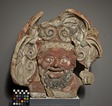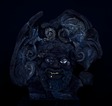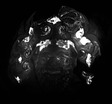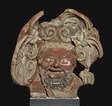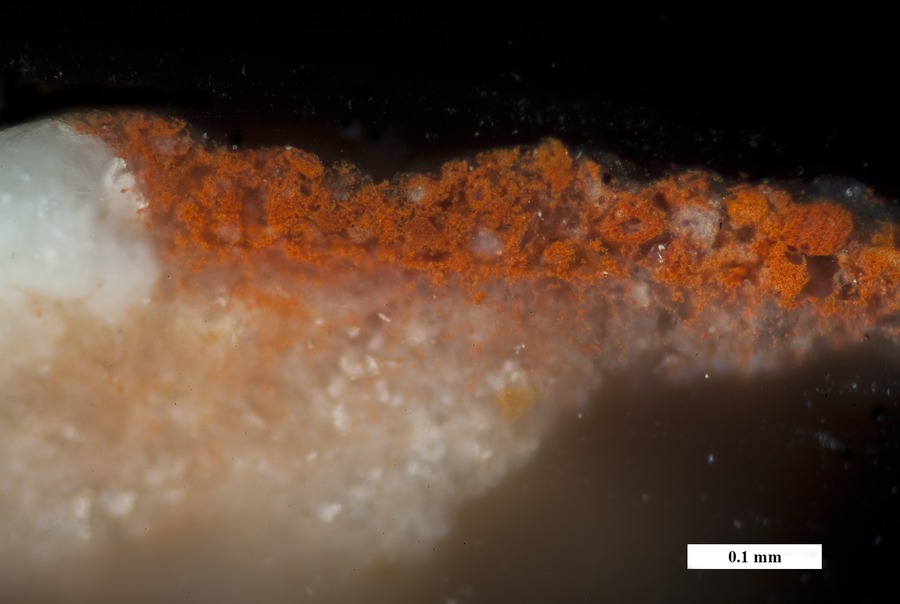Antefix with silen head
Summary
The polychromy on the antefix is rather well-preserved. The colour palette is limited to calcite, red ochre, carbon black and Egyptian blue. Mineral clays constitute an essential part of the entire stratigraphy suggesting that diluted clay has been used as a binder for the pigments.
Description of object
Antefix with large satyr head. It is made of pale brown clay (10YR 6/3) with many inclusions. The antefix is restored from several fragments. It is fairly complete, although parts of the shell frame are missing. The satyr head is surrounded by a large, deeply concave shell frame decorated with three upright, seven-leaf palmettes alternating with lotuses in relief. The satyr wears a wreath of ivy and has a round fleshy face with wrinkled forehead, large eyes, a broad nose, and a wide mouth with thick lips, which are slightly parted leaving the teeth visible. He has a beard of wavy strands and a thick moustache overlapping the beard.
Archaeological Commentary
There is one more antefix of the same type in the collection belonging to the Ny Carlsberg Glyptotek (HIN 69). At least five other examples of this type of antefix exist, all of which are also considered to be from Cerveteri: one in the Vatican (Museo Etrusco Gregoriano, inv. no. 14118), two in Philadelphia (Penn Museum, inv. nos. MS 1804 and 1805), and two in New York (Metropolitan Museum of Art, inv. nos. 96.18.159 and 96.18.160). Furthermore, there is a fragment of the same type in Paris.
Choice of methods
Visual examination
- Macroscopic
- Microscopic in situ
Technical imaging
- UV
- VIL
Sampling
- Cross section
- Microscopy
- SEM/EDX
- XRF
Visual examination
The satyr head has dark red skin which merges into the shell frame. The red skin tone is painted on top of a pink layer. A darker shade of red has been applied to the hair below the ears and, seemingly, on top of the head and inside the ears. The irises are red with black pupils. The beard, moustache, eye rims and brows are all painted black. The lips are painted red, the teeth white and the ivy a light shade of blue. The palmettes and lotus flowers are painted white and light blue on a bluish black background.
Technical imaging
UV-FL: Due to the fluorescence of the glue, the joints light up in the UV.
VIL: In the VIL image the dark background of the palmettes and the blue ivy light up because of the luminescent property of Egyptian blue.
Other types of investigation
XRF in situ: 01: Terracotta: Ca, Fe, K and S. 02: White on palmette: Raised levels of Ca and S. 03: Red skin colour: Increase in Fe and S, probably red ochre. 04: Black beard: No distinct differences from terracotta reading. 05: Blue ivy: Raised levels of Cu and S. Copper-based blue.
A sampling strategy was developed on the basis of the preliminary investigation. Three samples with a surface area of c. 1 mm2 were collected. Sample 1: Skin. Sample 2: Beard. Sample 3: Background colour of a palmette. The samples were prepared as cross-sections and examined with an optical microscope.
SEM-EDS (point analysis): All three cross-sectioned samples were examined using SEM-EDS. The preparatory white ground present in all three samples consists of calcium carbonate (CaCO3) and silicate compounds rich on aluminum. These compounds might constitute kaolinite (Al2Si2O5(OH)4). Thus, the white layer is based on calcite and, possibly, kaolin. The pink laye beneath the red skin tone is based on iron compounds mixed with calcium carbonate (CaCO3), i.e. red ochre mixed with calcite. The black pigment found on the beard as well as the background of the palmettes is carbon-based. Furthermore, mineral clays constitute an essential part of the entire stratigraphy. The chemical composition of these clay minerals indicates the use of kaolin (Al2Si2O5(OH)4). Usually, kaolin is easily recognizable with SEM due to its highly characteristic, hexagonal, plate-like shape. However, when exposed to firing temperatures excessing 500 °C, it loses its crystallographic order as it forms metakaolin.
Bibliography
C. Brøns, S.B. Hedegaard & M.L. Sargent (forthcoming) Painted Faces: Investigations into the polychromy of Etruscan antefixes In: Etruscan Studies.
J. Christiansen, N.A. & Winter (2010), Etruria I. Catalogue. Ny Carlsberg Glyptotek, no. 50, pp. 110.
C. Brøns (1), S. B. Hedegaard & K. L. Rasmussen (2018), The real thing? Studies of polychromy and Authenticity of Etruscan Pinakes at the Ny Carlsberg Glyptotek. Studi Etruschi LXXIX – MMXIV, 195-223.
S.B. Hedegaard (2018), Reconstructing Etruscan Architectural Polychromy: Antefixes from the Ny Carlsberg Glyptotek, in S. Bracci, G. Giachi, P. Liverani, P. Pallecchi & F. Paolucci (eds.) Polychromy in Ancient Sculpture and Architecture. Proceedings of the 7th Round Table, Florence, 4-7 November 2015, Sillabe, Florence, 36-42.
- HIN 68
- Antefix
- Late 4th cent. B.C.E.
- Classical
- Terracotta
- Acquired by the Ny Carlsberg Glyptotek in 1892.
- H. 48 cm.; W. 49.2 cm.
